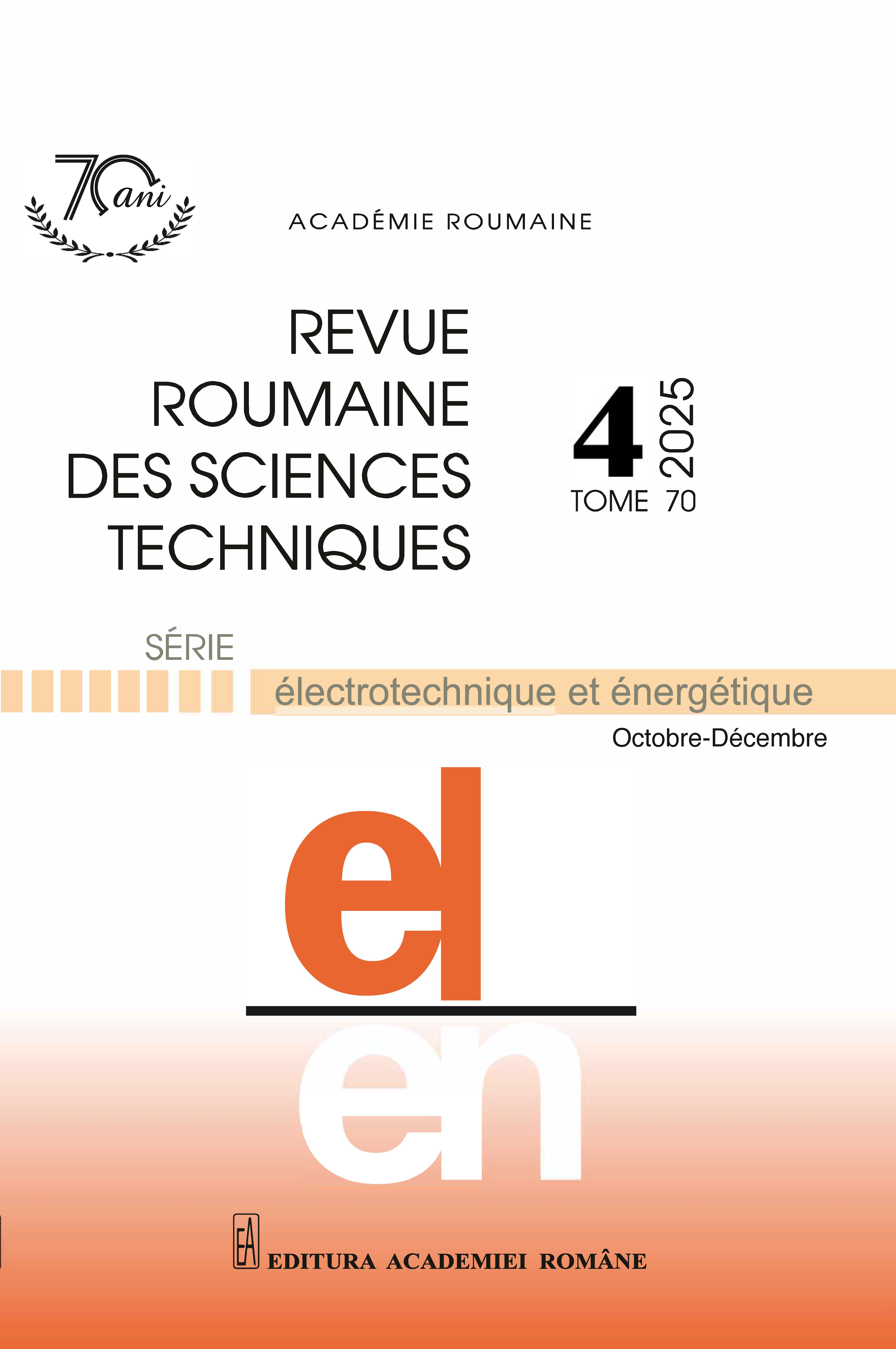APPROCHE MIXTE DE GESTION DU DÉCALAGE DOPPLER ET DE LA POLARISATION POUR LES COMMUNICATIONS PAR SATELLITE
DOI :
https://doi.org/10.59277/RRST-EE.2025.4.22Mots-clés :
Satellite ALSAT-2A, Satellite ALSAT-2B, Application CDM 600, Décalage Doppler, décalage Doppler estiméRésumé
Le déplacement rapide des satellites en orbite terrestre basse (LEO) pose plusieurs défis pour la communication avec le segment sol. L'un des principaux problèmes rencontrés est celui des décalages de fréquence Doppler importants, qui peuvent perturber la transmission des signaux et nécessiter des ajustements précis pour maintenir des communications stables. Cet article présente une solution logicielle permettant de compenser efficacement le décalage Doppler, ainsi qu'une implémentation matérielle pour gérer les deux polarisations disponibles à la station : la polarisation circulaire droite (RHCP) et la polarisation circulaire gauche (LHCP). Cette gestion de la polarisation est nécessaire car le démodulateur utilisé dans notre cas ne possède qu'une seule entrée. Cette solution a été mise en œuvre dans une station terrestre (GS) en bande S existante située à Oran, en Algérie. Les résultats expérimentaux obtenus lors des passages réels des satellites ALSAT-2A et ALSAT-2B, dont les orbites sont décalées de 180 degrés, ont été satisfaisants. La solution mise en œuvre a donné de bons résultats, avec une précision comparable à la fréquence Doppler estimée, sans aucune perte de télémétrie au niveau du segment sol.
Références
(1) L. Antiufrieva et al., Features of frequency synchronization algorithms DVB-S2 (X) for LEO satellites, In 2021 23rd International Conference on Digital Signal Processing and its Applications (DSPA), IEEE (2021).
(2) J.E. Benmansour and B. Khouane, Feed-forward control design for roll/yaw attitude flexible spacecraft based on the disturbance observer, Rev. Roum. Sci. Techn. – Électrotechn. et Énerg., 67, 2, pp. 187–191 (2022).
(3) J.E. Benmansour, R. Roubache, B. Khouane, and N. Bekhadda, Robust attitude controller and fault detection of flexible satellite, Rev. Roum. Sci. Techn. – Électrotechn. et Énerg., 70, 1, pp. 121–126 (2025).
(4) O. Nia and B.L. Mark, Models for frequency doppler shift prediction for LEO satellites at L-band, Military Communications Conference (MILCOM), IEEE (2022).
(5) E.G. Peters, K. Day, and C.R. Benson, A real-time Doppler compensating physical/data link layer protocol for satellite communications, In 2020 IEEE Aerospace Conference, IEEE (2020).
(6) E.G. Peters and C.R. Benson, A Doppler correcting software defined radio receiver design for satellite communications, IEEE Aerospace and Electronic Systems Magazine, 35, 2, pp. 38–48 (2020).
(7) M.Z. Baba-Ahmed, R.D. Taleb, M.A. Rabah, S. Benabbou, and M.I. Soufi, Hybrid design patch antenna for X-band satellite communication, Rev. Roum. Sci. Techn. – Électrotechn. et Énerg., 70, 3, pp. 379–384 (2025).
(8) A. Aloman, M.P. Garcia, I. Nicolaescu, F. Popescu, and L. Buzincu, Circularly polarized periodic leaky-wave antenna based on a coaxial line with helical slot, Rev. Roum. Sci. Techn. – Électrotechn. et Énerg., 70, 1, pp. 87–90 (2025).
(9) M. Katayama, A. Ogawa, and N. Morinaga, Carrier synchronization under Doppler shift of the nongeostationary satellite communication systems, Proceedings Singapore ICCS/ISITA92, IEEE (1992).
(10) J.J. Van de Beek, M. Sandell, and P.O. Borjesson, ML estimation of time and frequency offset in OFDM systems, IEEE Transactions on Signal Processing, 45, 7, pp. 1800–1805 (1997).
(11) I. Ali, N. Al-Dhahir, and J.E. Hershey, Doppler characterization for LEO satellites, IEEE Transactions on Communications, 46, 3, pp. 309–313 (1998).
(12) I. Ali et al., Doppler applications in LEO satellite communication systems, Vol. 656, Springer Science & Business Media (2005).
(13) S. Bekkar Djelloul Saiah et al., Analysis of the communication links between the AlSat‐1b satellite and the ground station: The impact of the Auto Tracking system on antenna pointing accuracy, International Journal of Satellite Communications and Networking, 39, 5, pp. 486–499 (2021).
(14) C.H. Cho et al., Antenna control system using step tracking algorithm with H∞ controller, International Journal of Control, Automation, and Systems, 1, 1, pp. 83–92 (2003).
(15) D. Nieto Yll, Doppler shift compensation strategies for LEO satellite communication systems, Universitat Politècnica de Catalunya (2018).
(16) H. Rouzegar, M. Nasirian, and M. Ghanbarisabagh, Novel algorithm for tracking LEO satellites using Doppler frequency shift technique, Wireless Personal Communications, 96, pp. 2161–2178 (2017).
(17) E. Bensikaddour et al., Azimuth, elevation, and Doppler shift estimation for LEO satellites based on an open source Python package, Automatic Control and Computer Sciences, 57, 2, pp. 203–212 (2023).
(18) C. Cao and S. Zhai, The influence of LEO satellite Doppler effect on LoRa modulation and its solution, In Journal of Physics: Conference Series, IOP Publishing (2021).
(19) A. Al-Hourani and B. Al Homssi, Doppler shift distribution in satellite constellations, IEEE Communications Letters (2024).
(20) A. Bab et al., hybrid implementation of a Doppler shift compensation solution for LEO satellite communication systems, International Symposium on Electronics and Telecommunications (ISETC), Timisoara, Romania, pp. 1–5 (2024).
(21) ***Comtech EF Data, CDM-600 Satellite Modem (2024).
(22) J.M. Gongora-Torres et al., Elevation angle characterization for LEO satellites: First and second order statistics, Applied Sciences, 13, 7, 4405 (2023).
(23) J. Mass and E. Vassy, Doppler effect of artificial satellites, In Advances in Space Science and Technology, Elsevier, pp. 1–38 (1962).
(24) Mini-Circuits, ZX80-DR230-S+ RF amplifier (2024). Available: https://www.minicircuits.com/pdfs/ZX80-DR230+.pdf?srsltid=AfmBOoqP2RYWioZNBWZihsQH4gSQPQuA4iFcqcaHxMDqTLzh4sMM
Téléchargements
Publiée
Numéro
Rubrique
Licence
(c) Copyright REVUE ROUMAINE DES SCIENCES TECHNIQUES — SÉRIE ÉLECTROTECHNIQUE ET ÉNERGÉTIQUE 2025

Ce travail est disponible sous licence Creative Commons Attribution - Pas d'Utilisation Commerciale - Pas de Modification 4.0 International.


